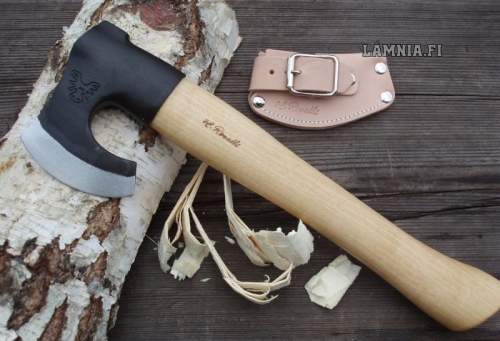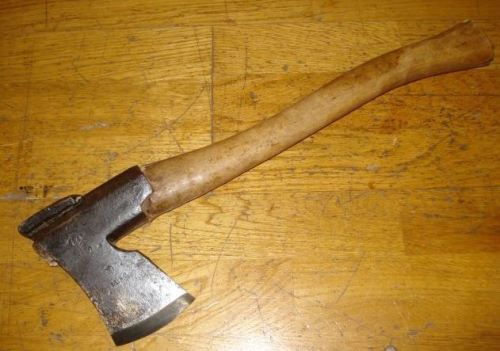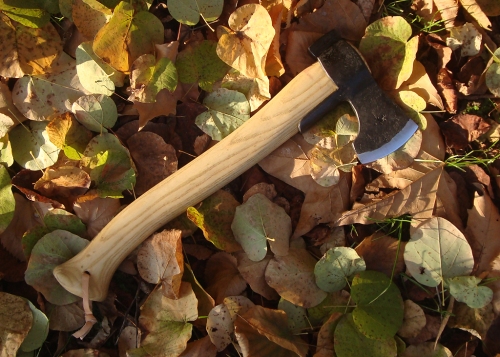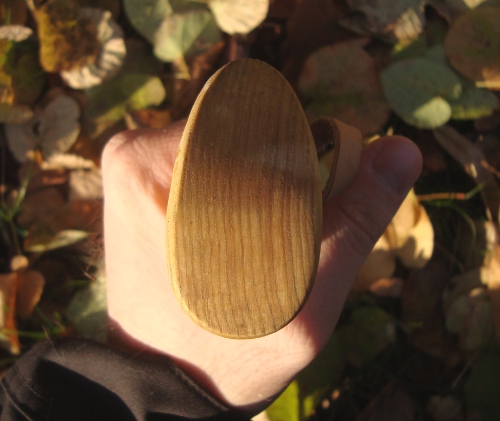I have an interest in the Finnish axe and asked Marcus Lepola if he would contribute an article to Nordiska Knivar on the subject. Marcus is an ethnologist, a museum professional and a Ph.D researcher at Åbo Akademi University in Turku Finland. Marcus is especially interested in primitive and traditional skills of the North, primarily Finland. He is also interested in practical wilderness skills and knowledge of people living in the Arctic and Subarctic. He has an excellent blog from where this article originated: http://northernwildernesskills.blogspot.com/
Thank you Marcus for sharing your knowledge of the Finnish axe!
An Introduction to Finnish Axe History
The excellent practicality, durability and quality of Finnish axes has recently been rediscovered by contemporary bushcrafters, hunters, craftspeople and
traditionalists alike. Long known and even iconic to most Finnish people, these axes seem a bit strange and exotic to the public outside of Finland. There is very little if any, written material about these axes in English, which explains why many non-Finns are a bit confused about all the different types of axes manufactured in Finland during the 19th and 20th centuries.
There is no single Finnish axe type, but may axes made in Finland have similarities that were retained in some archaic features of the axes. These features will be further discussed in this article.

A Finnish hunter carrying a Bila-axe and a crossbow, the archer is a
Russian. Olaus Magnus, Historia de gentibus septentrionalibus 1555.
Finnish Axes From An Ethnological Perspective
Most Finnish axes have a distinctive collar or sleeve. Extended collars on
axe-heads became common in Western-European utility axes during the
Middle-Ages. The collar was developed to aid in the shafting of the axe and to
add durability as it increases the area of the shafted portion. East-European or Russian axes developed a “beard” to function in a similar way as a collar. The beard is an extended tip that grows out from the bottom part of the axe head, just at the eye and makes for a more durable shafting.
The Karelian type axe has two beards. These “beards” are two similar extensions in the front and the back half of the axe head and this axe type is a middle form of the full collars European utility axe and the Russian axe.
Several different styles and versions of axes suited for local needs were
developed by local smiths and forges. These broad axes with long collars are
referred to as Bila (Swedish) or Piilu (Finnish).

Karelian man in a woodsman ́s outfit with the distinctive “kukkeli” hood and
a Karelian type axe with partial collar of the shaft. Louis Sparre 1892. Source
“Kalevalaseura – The Kalevala Society of Finland”.
Collar-axes remained popular in Finland because there was a high demand on durability due to the versatility of axe usage. Most people in Finland could not afford to own a lot of axes, let alone carry all these axes with them to the field. One axe had to fit the bill and the axe was used for all things possible. The long collar made the axe more durable, and the handle fitted snugly inside the long collar. The wide edges of the Bila styled axes were preferred as this made it easier to carve logs for houses and they also proved efficient when cleaning branches of logs.

Medieval axes found in Uppsala, Sweden. These types of axes were further
developed by Finnish blacksmiths. UM20997, Upplandsmuseet.
- Three axes from the 18th
century made by local blacksmiths in the Pargas
local history museum. All three are of the Bila-axe type, but only one axe has a long
collar extending from the eye. Photo by Marcus Lepola.
The overall size of axes remained fairly small until the 19th century due to the fact that iron was a valuable commodity and a good axe could be handed down from father to son. Traditionally iron was manufactured from iron ore found in the bottom of Finnish lakes and marshes. As industrially produced steel became available, this gradually increased the size of the axes.
As mentioned earlier the collared axes were tremendously well developed for heavy use in the Finnish forests. The axe was a virtual all-functional tool for the Finns, much like a “Swiss-army knife”. The axe could be used for a number of different things and was always carried along. The importance of the tool is evident in the way they were stored in the old days. The axes were kept in a rack above the main door so it would be readily available when venturing out. There is also another possible, superstitious reason, for keeping axes above the entrance to the cottages. Finns believed in all kinds of different supernatural forces such as ghosts, guardian spirits (haltia), trolls and such that could be dangerous if they were allowed to enter in to the houses. Sharp steel objects such as knives and axes were magically potent to deter unwanted spirit-beings from entering a home and hanging axes above the doors would be an effective way to keep them away.

Axe rack with axe and a sauna branch above the doorway in an old Finnish
cottage at Pargas local history museum. Photo by Marcus Lepola.
Among old axes found today a version of the Bila, the Billnäs model number
12:1-3 outnumbers all others and was the most popular of all the models
manufactured due to its versatility in felling trees. This type, called the Kemi or Hult ́s type, was also manufactured by Kellokoski-Mariefors, and labeled with the same model number 12. Kellokoski-Mariefors also had another, very similar axe, the Finspong, originally from Sweden. The Finspong is very similar to the Kemi type, but it has a wider edge. Curiously, the name Finspong is said to derive from Finns who were the first to settle the area.
Finland was part of Sweden for some 700 years until 1809 and Finns, especially the Savo, migrated to the uninhabited parts of Northern Finland and worked their way down through Sweden and pioneered the establishment of new settlements.
The Finnish migrations were fueled by the constant need for new
agricultural lands. A family would settle in a wilderness, burn and slash down
some forest and plant rye and turnips among the ashes for a few years.
Additional food was provided through animal husbandry. Hunting, fishing and gathering were also important. This type of livelihood could only be maintained for a few years before locally available resources were spent and the household had to move. The Finns reached Sweden by the 17th century. The Swedes were worried that the Finns would burn down all the valuable timber needed for the ironworks and shipyards so they sent some of them away to Swedish colonies in Delaware in America to slash and burn in the woods inhabited by Indians. The Finns probably fit well in with the Native Americans as their most valued possessions in addition to the rye and turnips and the odd cow and dog was the knife, the axe, the bow and the spear.

Six 19th century axes in the Pargas local history museum. The three broad
“Bilas” are of unknown Finnish manufacture. One is marked with a B-stamp and
another with a W-stamp. The third one is unmarked. A Billnäs nr 7 is the second one from the top. The broad Russian style axe at the bottom is unusual as it is of Swedish manufacture, From Lunds bruk in Örebro. The standing axe is of unknown manufacture, probably an early Kellokoski. Photo by Marcus Lepola.
Logging And Axes
In Finland logging season started in January. Logs were transported out on
sledges pulled by horses. It was not unusual for temperatures to fall well below -20 Celsius. In these conditions, wood dries and shrinks. Wood becomes more brittle and brash as it dries up and freezes. If the handle is fitted on a narrow axe the risk for breakage at the eye of the axe-head will dramatically increase, especially when twisting the axe sideways which is common when splitting trunks. A long collar improves durability in these harsh conditions and gives a better grip of the wood.
Additional tricks were used to make sure that the handle fitted snugly to the eye of the axe. Tar and birch-bark were often added on the joint before shafting the head to improve the hold. Boiling the head portion of the shaft in water before attaching the head is also an old trick that has been proven. Even if the wood swells up due to added moister content, the head will still go a bit further down over the softened shaft. The shaft was also developed to fit well in to the hand of the user, even when wearing thick gloves in cold winter conditions. Axe handles would sometimes be roughed on the surface to provide additional grip for the user.
It was common that the men using the axes would make the shafts themselves in accordance to personal preference. Wood and lumber did not hold a real value when standing as living trees in the forest. Trees had to be felled with axes to produce firewood, boards and hewn lumber. The only tools used were broad or true Bilas and axes. Crude waterpower sawmills came in to use in some parts of Finland in the 17th century but the handsaw did not find its way in to the toolkit of a Finnish lumberjack until the latter part of the 19th century.
With the development of sawmills in the late 19th century forests became a
commodity and forestry and logging gave a small, but steady income to rural
people. At best, some 500 000 people earned at least a part of their living from logging and forestry during the poor years in 1950. These are impressive figures considering that the population of Finland was 4 million at that time.

Finnish builders from the turn of the 20th
century with axes and saws. Photo from The Finnish
Literary Society (SKS).

Hard work. During WWII Finland was caught in battle with the Soviet Union,
while the men were at the front, woman and children had to do their share to keep
the country going. A young boy has finished cutting fire wood for the winter. Though job for anyone, let alone a young boy. Image from the Lusto Forest Museum.
There was a growing need for high quality durable axes. As mentioned earlier
the axes produced by the forges in Finland relied mainly on established models, previously made by local smiths. The Kemi and Finspong types were clearly the ones most suited for the old Finnish slash and burn farmers and not surprisingly, this model also became one of the most popular all around axes.
Finnish Axe Handles
The Finnish collar axes worked well with traditional birch handles. Gradually
new materials became available as well as store bought handles. Many still
continued to make their own handles well in to the 1960s as it was believed
that they were superior to store bought shafts. People would go to all lengths to get proper shafting material for their axes. One way to improve the quality of the wood was to de-bark one side of a living birch. The exposed part of the
trunk became more weathered and durable. The wood becomes very dark and heavy. The only problem with this method is that it took some 15-25 years before the hardened wood could be harvested. That is why fathers made sure to have a lot of processed trees at different stages around so that their sons and grandsons would have an ample stock of axe-handles when they needed them. Also distinct handle models were passed down in family lineages from fathers to sons.
The wooden handles of utility axes were further developed during WWII as
there was a need to improve knowledge about axe usage. The war with the
Soviet Union forced women and children to work in the forests to gather
firewood and lumber for the industry. A booklet called “A guide to tools used in the woods” was published in 1940 and distributed widely. The booklet
had blueprints of axe handles suited for utility axes. Also the Finnish work
efficiency association organized the manufacture and distribution of
axe-handles made by the soldiers at the front to the people back home.
A utility axe-handle suited for a 12:2 model axe is 60-70 cm in length, for
splitting axes the handle should be 10cm longer. In felling and chopping a long handle transmits more power but it less accurate. If the handle is too short it will strain the back of the worker as he is forced to work in a bent over posture.
A trick to measure up the correct length of the handle is to place the tip of the
handle on the floor and stand next to it. The pommel of the handle should
reach the second joint of the middle finger. A splitting axe handle should reach the palm of the hand. A good handle has a downward bend, the lower grip portion should be well defined and the pommel nob should be wide and round.
The handle has to be fairly flat at the grip and the whole shaft tapers towards
the grip. Every man was expected to make their own axe-handle. Some
handles were true works of art and perfectly shaped, tapered and balanced.
Crude and misshapen handles were often ridiculed as “axe carrying wood”. A
man who took all day to make an axe handle was also ridiculed as “worthless”.
Hickory shafts became available in Finland after the war and became
increasingly popular. However people noticed that the stiff hickory wood was
harder on the hands as it was less flexible than birch and vibrated heavily on
impact. Hickory was also prone to split along the grain in really low winter
temperatures. The traditional birch handles had been proven unbeatable.
Before the advent of chain saws, the axe remained as the single most
important tool for cutting down timber as old type of saws were unreliable.
Finnish lumberjacks also preferred an axe that was well suited for splitting large chunks of wood. The blade of the axe had to be slim and wedge-like so it would penetrate deep in to the wood. It should also be heavy and durable so it could be wedged deeper in to the wood with another axe to aid splitting. The axe was also used for a number of other things, such as banging bears on the head during winter hunts but that is a different story.
Forges And Ironworks In Finland
Up until the time of industrialization, most axes were made locally by rural
blacksmiths. Different laws imposed by the Swedish kingdom restricted
craftsmen from establishing businesses outside of towns or castles, but these
restrictions did not have considerable impact on rural blacksmithing even If the profession of parish blacksmiths did not receive official approval until 1739. The oldest historic account of blacksmithing goes back to the 14th
century. Blacksmiths were important members of rural agricultural communities as their services were necessary to maintain and produce the tools necessary for everyday life. Blacksmiths started to specialize in the manufacture of certain products as early as the 16th century, such as gunsmiths, knife-smiths and axe-smiths. As axes were made locally there was a great deal of variation in axe models.
The industrialization of Finland was initiated in the 17th century with the
establishment of the first industrial ironworks in Western Nyland. The first
ironworks was established in Svartå at the expense of the Swedish Crown in
1616, followed by the Ironworks in Antskog in 1630. The ironworks at Billnäs
were established in 1641 and in 1649 ironworks were also established in
Fiskars. The Strömfors ironworks in East Nyland was established in 1698 but
received its final name in 1744. Kellokoski-Mariefors Ironworks was established in 1795. Several other forges and ironworks were also established in Finland during the 18th century such as the Dalsbruk Ironworks and a similar one in Björkboda. Ironworks were also established in Ostrobothnia such as the Kimo ironworks during the early part of the 18th century.
However axes produced by these ironworks were not standardized until the end of the 19th century when only Billnäs, Kellokoski-Mariefors and Strömfors remained as main manufacturers of axes. It is interesting to note that among the first axes produced at the Billnäs ironworks was a halberd- or a battle-axe. These axes were made to arm the Swedish troops fighting in the 30-year war in mainland Europe.
Axes manufactured industrially at Billnäs and Kellokoski remained true to
localized version developed by blacksmiths all around Finland. That is also why the axes, in addition to a model number, also had a name which referred to the locality of the axe type. The market for axes changed in the mid 19th
century as Finland, then part of Russia, was able to increase the export of axes and other steel implements to Russia as import taxation of Finnish products ended in 1835. The production of axes at Billnäs grew with 500% by 1880. Also the availability of American and British axes forced the Finnish ironworks to step up their production. At Billnäs the owners followed the example of Swedish ironworks, which at the time were highly industrialized.
Up until then the smiths at Billnäs had made axes and other utensils using the same methods as any other village blacksmiths for some 200 years. As of 1888 onward axes were made using American machine-hammers and by the end of the 19th century the factory could produce as much as 2000 axes per day.

Finnish style axes manufactured by the Kellokoski-Mariefors ironworks.
Models 9 and 10 are the Karelian type.

The Forge at Strömfors also made axes but they were not able to compete
with Billnäs or even Kellokoski-Mariefors. The models they made were identical with the other forges, except for the model 2 which was only made by Strömfors and was modeled after the Viborg style axe. The models 15, 11 and 9 are considered “American” axes.
Finnish Axes In A Modern Context
The production of the popular Kemi model stopped in the 1970s. The last axe
with a wooden shaft was made forged in 1995 in Billnäs. The traditional axes
were replaced by the modern Handy-series axes which are made of composite
material and have no eye. These axes are efficient, but banging on the head of
the axe to aid splitting is not possible as this will shatter the axe.
Since then the Ray Mears show “Bushcraft” and other survival shows have
made people more aware of traditional outdoors gear and boosted the sales of
traditional axes such as the axes of the Gränsfors forge. The truth of the matter is that never before have so many high quality axes been available for the public. The irony is that most of these axes are used in a recreational context.

A modern Finnish axe from H. Roselli available from http://www.Lamnia.fi
This means that most users will only need the axes for splitting fire wood, cutting saplings and some carving. This is completely understandable as cutting live wood is prohibited in most hiking areas in Europe, and even North America, so very few people will ever use the axe to the same extent as an old Finnish lumberjack/slash and burn farmer who is cutting down huge pines one day, building a fence of split trunks the next day and hewing and cutting out joints for a wooden cottage on the third day – all with the same axe.
In fact most people alive today are not capable of handling an axe as well as
the Finnish oldtimer or Äijä, because they never get to use the axes in the
same versatile way. Axes are dangerous for the user and you can inflict some
serious damage to your legs if you don ́t know how to use it. This is made
vividly clear by the teaching videos made by Ray Mears (video link in the
bottom of the page).
Luckily there are some old documentary clips made by Finnish ethnographers of some oldtimers making use of the axe in a very versatile manner. These men were using axes as young children and learned the craft gradually over a period of several decades. Their skill is evident in the way the effortlessly use the axe for carving and chopping. These documented skills are an inspiration to anyone interested in learning and preserving old carpentry techniques.

The iconic Billnäs nr 12. The model in the photo is the smaller, 12:3 version
of the famous Kemi axe.
All material copyright by Marcus Lepola 2013.
Addendum:
Here is a very nice contemporary Finnish axe made by Pasi Hurttila. The head is forged from a single piece of spring steel and the handle is made of ash. The neck protection is iron, welded to the steel head. Photos are courtesy of Federico Buldrini.
Further reading, only in Finnish
Maasola, Juha: Kirves. Helsinki: Maahenki, 2009.
Sirelius, U.T. Sirelius U.T.: Suomen kansanomaista kulttuuria : esineellisen
kansatieteen tuloksia 1-2
Otava, Helsinki 1919-1921.
Internet resources:
Kellokoski product catalog: http://digi.lib.helsinki.fi/pienpainate/secure/showPage.html?action=page&type=lq&conversationId=1&id=338918&pageFrame_currPage=1
Billnäs product catalog: http://digi.lib.helsinki.fi/pienpainate/secure/showPage.html?action=page&type=lq&conversationId=2&id=338807&pageFrame_currPage=1
An archive film on how to shaft an axe from the Finnish Film Series “Isien työt” -The labours of our fathers”. These films were filmed by Sakari Pälsi in
1936-1939. He filmed five films in total of different Finnish traditional crafts, games, fishing etc. The man making the axe-handle is Iivari Mattila from Renko, Finland. He was 80 years old at the time and he was also referred to as “The old man (äijä)from Rauhaniemen.
http://www.youtube.com/watch?v=vcfwlfz_tGs
The same series as above, this time showing how a split stave fence was made using axes.
http://www.youtube.com/watch?feature=player_detailpage&v=4fdCFheNS_Q
Finnish home front from 1942, wood cutting and axe handle making.
http://yle.fi/elavaarkisto/artikkelit/koko_kansa_talkoissa_34217.html#media=34218
Ray Mears choosing and using an axe.
http://www.youtube.com/watch?v=2tUUctg6dfk&feature=player_detailpage










